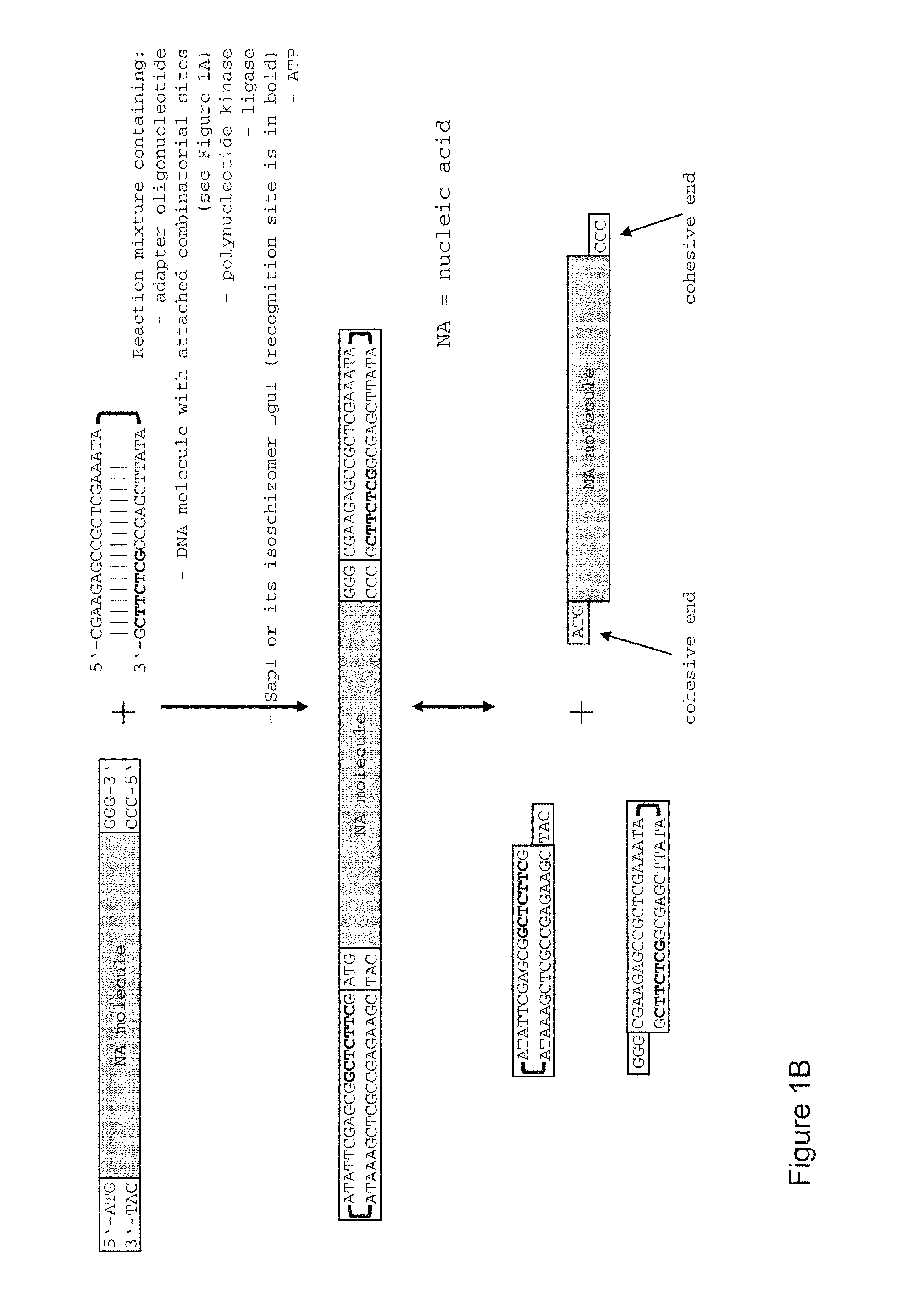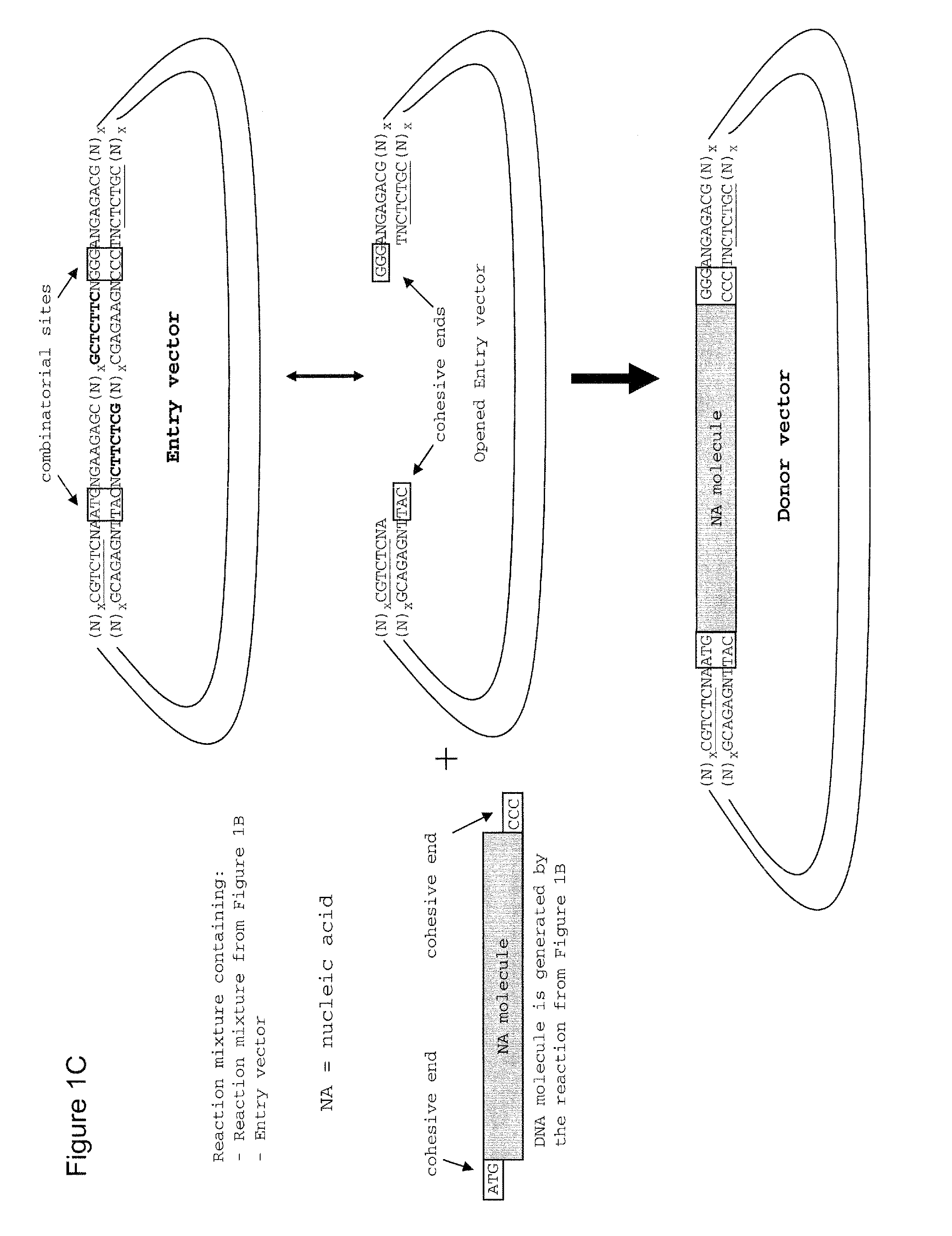Method of cloning at least one nucleic acid molecule of interest using type iis restriction endonucleases, and corresponding cloning vectors, kits and system using type iis restriction endonucleases
a technology of restriction endonucleases and nucleic acid molecules, applied in the field of polynucleotide manipulation techniques, can solve the problems of inability to predict the best combination of these tools, slow and inefficient traditional subcloning strategies, and limitations
- Summary
- Abstract
- Description
- Claims
- Application Information
AI Technical Summary
Benefits of technology
Problems solved by technology
Method used
Image
Examples
experimental examples
Experimental Example 1
Cloning of GFP in a Donor Vector
Generation of the Adapter Oligonucleotide
[0223]200 μl of a solution containing the adapter oligonucleotide (5′-CGA AGA GCC GCT CGA AAT AAT ATT CGA GCG GCT CTT CG-3′) (SEQ ID NO: 26) in a concentration of 10 μM in 1×PCR buffer with enhancer (Invitrogen; Cat. no. 11495-017) was introduced in a sealed 0.5 ml reaction vessel which was then incubated for 15 min in 600 ml boiling water. After incubation, the reaction vessel in the 600 ml water bath had been transferred into a box of Styrofoam (3 cm wall thickness). The closed Styrofoam box was incubated in the cold room (+4° C.) to allow slow cooling and annealing of the adapter oligonucleotide. The annealed adapter oligonucleotide was then stored at +4° C. in the refrigerator.
Generation of the Donor Vector Containing as Nucleic Acid Molecule a Gene Encoding GFP
[0224]GFP was amplified by PCR using thermostable proofreading Pfu polymerase (Fermentas, Cat. no. EP0502) with dedicated prim...
experimental example 2
Transfer of a Nucleic Acid Fragment via LguI
[0234]A nucleic acid fragment encoding a protease cleavage site (Prescission) and the lacZ alpha peptide under control of the lac promoter (lac P / Zα) was transferred from pTS-PCS(blue) (SEQ ID NO: 4) including convergently oriented LguI recognition sites and a kanamycin resistance gene as selectable marker into pALD3.1_Amp (SEQ ID NO: 5) including divergently oriented LguI recognition sites and an ampicillin resistance gene as selectable marker thereby generating pAU-7(blue) (SEQ ID NO: 6). The transfer reaction comprises incubating[0235]500 ng pTS-PCS(blue)[0236]50 ng pALD3.1_Amp[0237]2 u T4 DNA ligase (Fermentas, Cat. no. EL0013)[0238]5 u LguI (Fermentas, Cat. no. ER1932)[0239]0.5 mM ATP (Sigma, Cat. no. A2383)[0240]1× buffer Tango (Fermentas, Cat. no. BY5)
in a final volume of 50 μl for 1 h at 30° C. Then, 5 μl of the mixture were gently mixed with 50 μl chemically competent E. coli DH5α (prepared according to Inoue et al., 1990, Gene 96...
experimental example 3
Transfer of a Nucleic Acid Fragment Via Eco31I
[0241]A nucleic acid fragment encoding the lacZ alpha peptide under control of the lac promotor (lacP / Zα) was transferred from pAU-1(blue) (SEQ ID NO: 7) including convergently oriented Eco31I recognition sites and an ampicillin resistance gene as selectable marker into pAU-wt (SEQ ID NO: 8) including divergently oriented Eco31I recognition sites and a kanamycin resistance gene as selectable marker thereby generating pTU-((blue) (SEQ ID NO: 9). The transfer reaction comprises incubating[0242]500 ng pAU-1(blue)[0243]50 ng pTU-wt[0244]2 u T4 DNA ligase (Fermentas, Cat. no. EL0013)[0245]10 u Eco31I (Fermentas, Cat. no. ER 0291)[0246]0.5 mM ATP (Sigma, Cat. no. A2383)[0247]1× buffer G (Fermentas, Cat. no. BG5)
in a final volume of 50 μl for 1 h at 30° C. Then, 5 μl of the mixture was gently mixed with 50 μl chemically competent E. coli TOP10 (prepared according to Inoue et al., 1990, Gene 96, pp 23-28, 5*107 cfu / μg pUC DNA) and incubated on i...
PUM
| Property | Measurement | Unit |
|---|---|---|
| thickness | aaaaa | aaaaa |
| volume | aaaaa | aaaaa |
| volume | aaaaa | aaaaa |
Abstract
Description
Claims
Application Information
 Login to View More
Login to View More - R&D
- Intellectual Property
- Life Sciences
- Materials
- Tech Scout
- Unparalleled Data Quality
- Higher Quality Content
- 60% Fewer Hallucinations
Browse by: Latest US Patents, China's latest patents, Technical Efficacy Thesaurus, Application Domain, Technology Topic, Popular Technical Reports.
© 2025 PatSnap. All rights reserved.Legal|Privacy policy|Modern Slavery Act Transparency Statement|Sitemap|About US| Contact US: help@patsnap.com



